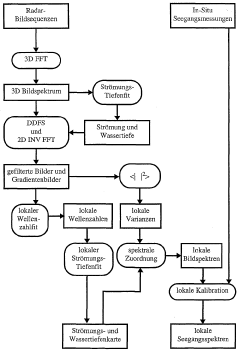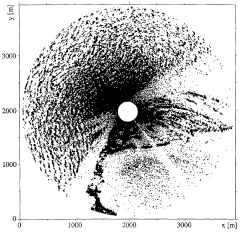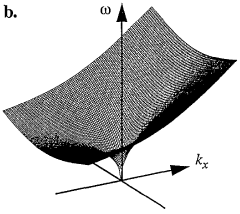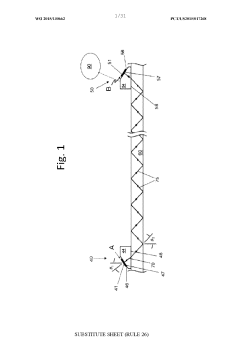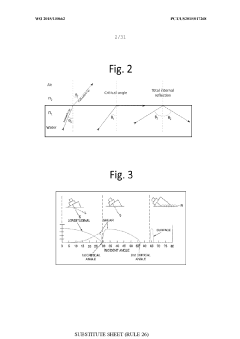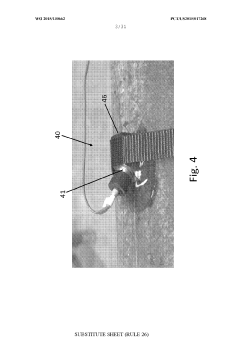Longitudinal wave analysis in hydrodynamic modeling
AUG 13, 20259 MIN READ
Generate Your Research Report Instantly with AI Agent
Patsnap Eureka helps you evaluate technical feasibility & market potential.
Hydrodynamic Modeling Background and Objectives
Hydrodynamic modeling has evolved significantly over the past century, becoming an essential tool in various fields such as oceanography, coastal engineering, and naval architecture. The study of longitudinal waves within this context has gained increasing importance due to its relevance in understanding complex fluid dynamics phenomena. The historical development of hydrodynamic modeling can be traced back to the early 20th century, with pioneering work by scientists like Ludwig Prandtl and Theodore von Kármán laying the foundation for modern fluid dynamics.
As computational capabilities have advanced, so too has the sophistication of hydrodynamic models. The integration of longitudinal wave analysis into these models represents a critical step forward in accurately representing real-world fluid behaviors. Longitudinal waves, characterized by oscillations parallel to the direction of wave propagation, play a crucial role in various hydrodynamic processes, including ocean surface dynamics, internal wave propagation, and acoustic wave transmission in fluids.
The primary objective of incorporating longitudinal wave analysis into hydrodynamic modeling is to enhance the accuracy and predictive power of these models. By accounting for the complex interactions between longitudinal waves and other fluid phenomena, researchers aim to develop more comprehensive and reliable simulations of fluid behavior. This improved modeling capability has far-reaching implications across multiple industries and scientific disciplines.
In the field of oceanography, for instance, better longitudinal wave analysis can lead to more accurate predictions of wave patterns, currents, and energy dissipation in coastal areas. This information is vital for coastal management, marine engineering projects, and understanding the impact of climate change on ocean dynamics. Similarly, in naval architecture, enhanced modeling of longitudinal waves can improve ship design by providing more precise estimates of hull stress and stability under various sea conditions.
The evolution of hydrodynamic modeling techniques has been closely tied to advancements in computational power and numerical methods. Early models were limited by simplifying assumptions and computational constraints, often neglecting or oversimplifying the role of longitudinal waves. However, as computing capabilities have grown exponentially, more sophisticated models have emerged, capable of incorporating complex wave interactions and non-linear effects.
Looking ahead, the field of hydrodynamic modeling, particularly in relation to longitudinal wave analysis, is poised for further significant advancements. The integration of machine learning and artificial intelligence techniques promises to enhance model accuracy and efficiency. Additionally, the increasing availability of high-resolution observational data from satellites and ocean monitoring systems will provide valuable inputs for model validation and refinement.
As computational capabilities have advanced, so too has the sophistication of hydrodynamic models. The integration of longitudinal wave analysis into these models represents a critical step forward in accurately representing real-world fluid behaviors. Longitudinal waves, characterized by oscillations parallel to the direction of wave propagation, play a crucial role in various hydrodynamic processes, including ocean surface dynamics, internal wave propagation, and acoustic wave transmission in fluids.
The primary objective of incorporating longitudinal wave analysis into hydrodynamic modeling is to enhance the accuracy and predictive power of these models. By accounting for the complex interactions between longitudinal waves and other fluid phenomena, researchers aim to develop more comprehensive and reliable simulations of fluid behavior. This improved modeling capability has far-reaching implications across multiple industries and scientific disciplines.
In the field of oceanography, for instance, better longitudinal wave analysis can lead to more accurate predictions of wave patterns, currents, and energy dissipation in coastal areas. This information is vital for coastal management, marine engineering projects, and understanding the impact of climate change on ocean dynamics. Similarly, in naval architecture, enhanced modeling of longitudinal waves can improve ship design by providing more precise estimates of hull stress and stability under various sea conditions.
The evolution of hydrodynamic modeling techniques has been closely tied to advancements in computational power and numerical methods. Early models were limited by simplifying assumptions and computational constraints, often neglecting or oversimplifying the role of longitudinal waves. However, as computing capabilities have grown exponentially, more sophisticated models have emerged, capable of incorporating complex wave interactions and non-linear effects.
Looking ahead, the field of hydrodynamic modeling, particularly in relation to longitudinal wave analysis, is poised for further significant advancements. The integration of machine learning and artificial intelligence techniques promises to enhance model accuracy and efficiency. Additionally, the increasing availability of high-resolution observational data from satellites and ocean monitoring systems will provide valuable inputs for model validation and refinement.
Market Applications of Longitudinal Wave Analysis
Longitudinal wave analysis in hydrodynamic modeling has found significant applications across various market sectors, driving innovation and enhancing efficiency in numerous industries. The offshore energy sector, particularly oil and gas exploration, heavily relies on this technology for seismic surveys and subsea pipeline inspections. By analyzing longitudinal waves propagating through water and subsurface structures, companies can accurately map potential hydrocarbon reserves and assess the integrity of underwater infrastructure, leading to more precise drilling operations and reduced environmental risks.
In the maritime industry, longitudinal wave analysis plays a crucial role in ship design and naval architecture. Naval engineers utilize this technique to optimize hull shapes, reducing drag and improving fuel efficiency. Additionally, it aids in predicting vessel behavior in different sea conditions, enhancing safety and performance. The technology has also been instrumental in developing advanced sonar systems for both military and commercial applications, improving underwater navigation and object detection capabilities.
The field of oceanography has greatly benefited from longitudinal wave analysis, enabling researchers to study ocean dynamics, climate patterns, and marine ecosystems with unprecedented accuracy. Climate scientists use this technology to model ocean currents and heat transfer, contributing to more accurate climate change predictions and understanding of global weather patterns. Marine biologists leverage longitudinal wave analysis to study marine mammal communication and migration patterns, aiding in conservation efforts and ecosystem management.
In the realm of coastal engineering, longitudinal wave analysis is essential for designing and maintaining coastal structures such as breakwaters, seawalls, and offshore wind farms. By modeling wave behavior and its interaction with structures, engineers can develop more resilient and cost-effective coastal protection systems. This technology also supports the growing offshore renewable energy sector, optimizing the placement and design of wind turbines and wave energy converters to maximize energy production while minimizing environmental impact.
The aquaculture industry has also embraced longitudinal wave analysis to improve fish farm designs and operations. By studying wave patterns and their effects on underwater structures, aquaculture engineers can create more robust and efficient fish pens, reducing the risk of escapes and improving fish health. This application has contributed to the sustainable growth of the aquaculture sector, meeting the increasing global demand for seafood while minimizing environmental impacts.
In the maritime industry, longitudinal wave analysis plays a crucial role in ship design and naval architecture. Naval engineers utilize this technique to optimize hull shapes, reducing drag and improving fuel efficiency. Additionally, it aids in predicting vessel behavior in different sea conditions, enhancing safety and performance. The technology has also been instrumental in developing advanced sonar systems for both military and commercial applications, improving underwater navigation and object detection capabilities.
The field of oceanography has greatly benefited from longitudinal wave analysis, enabling researchers to study ocean dynamics, climate patterns, and marine ecosystems with unprecedented accuracy. Climate scientists use this technology to model ocean currents and heat transfer, contributing to more accurate climate change predictions and understanding of global weather patterns. Marine biologists leverage longitudinal wave analysis to study marine mammal communication and migration patterns, aiding in conservation efforts and ecosystem management.
In the realm of coastal engineering, longitudinal wave analysis is essential for designing and maintaining coastal structures such as breakwaters, seawalls, and offshore wind farms. By modeling wave behavior and its interaction with structures, engineers can develop more resilient and cost-effective coastal protection systems. This technology also supports the growing offshore renewable energy sector, optimizing the placement and design of wind turbines and wave energy converters to maximize energy production while minimizing environmental impact.
The aquaculture industry has also embraced longitudinal wave analysis to improve fish farm designs and operations. By studying wave patterns and their effects on underwater structures, aquaculture engineers can create more robust and efficient fish pens, reducing the risk of escapes and improving fish health. This application has contributed to the sustainable growth of the aquaculture sector, meeting the increasing global demand for seafood while minimizing environmental impacts.
Current Challenges in Longitudinal Wave Modeling
Longitudinal wave modeling in hydrodynamics faces several significant challenges that hinder accurate predictions and limit the applicability of current models. One of the primary obstacles is the complexity of nonlinear interactions between waves and structures. As waves propagate through fluid mediums, they encounter various obstacles and boundaries, leading to complex reflection, refraction, and diffraction patterns. These interactions are often highly nonlinear, making them difficult to capture accurately in mathematical models.
Another major challenge lies in the multiscale nature of longitudinal wave phenomena. Hydrodynamic systems often involve processes occurring at vastly different spatial and temporal scales, ranging from microscopic fluid dynamics to large-scale wave propagation. Bridging these scales in a single model remains a formidable task, as it requires balancing computational efficiency with accuracy across multiple orders of magnitude.
The presence of turbulence adds another layer of complexity to longitudinal wave modeling. Turbulent flows are characterized by chaotic fluctuations and energy cascades across different scales, which significantly affect wave propagation and energy dissipation. Accurately representing turbulence in wave models is crucial for predicting wave-induced loads and sediment transport, yet it remains one of the most challenging aspects of hydrodynamic modeling.
Furthermore, the coupling between longitudinal waves and other physical processes poses significant challenges. For instance, the interaction between waves and currents, or the influence of wind on wave generation and propagation, introduces additional complexities that are difficult to capture in a single model. These coupled phenomena often require interdisciplinary approaches and the integration of multiple physical models.
Data assimilation and validation present another set of challenges in longitudinal wave modeling. While advancements in sensor technology have improved data collection capabilities, integrating this data into models and using it to validate and improve predictions remains a complex task. The sparsity of data in certain regions, particularly in deep ocean environments, further complicates the validation process.
Lastly, the computational demands of high-fidelity longitudinal wave models pose significant challenges. As the resolution and complexity of models increase to capture more detailed physics, so do the computational requirements. Balancing model accuracy with computational efficiency is an ongoing challenge, particularly for real-time applications or large-scale simulations covering extensive spatial and temporal domains.
Another major challenge lies in the multiscale nature of longitudinal wave phenomena. Hydrodynamic systems often involve processes occurring at vastly different spatial and temporal scales, ranging from microscopic fluid dynamics to large-scale wave propagation. Bridging these scales in a single model remains a formidable task, as it requires balancing computational efficiency with accuracy across multiple orders of magnitude.
The presence of turbulence adds another layer of complexity to longitudinal wave modeling. Turbulent flows are characterized by chaotic fluctuations and energy cascades across different scales, which significantly affect wave propagation and energy dissipation. Accurately representing turbulence in wave models is crucial for predicting wave-induced loads and sediment transport, yet it remains one of the most challenging aspects of hydrodynamic modeling.
Furthermore, the coupling between longitudinal waves and other physical processes poses significant challenges. For instance, the interaction between waves and currents, or the influence of wind on wave generation and propagation, introduces additional complexities that are difficult to capture in a single model. These coupled phenomena often require interdisciplinary approaches and the integration of multiple physical models.
Data assimilation and validation present another set of challenges in longitudinal wave modeling. While advancements in sensor technology have improved data collection capabilities, integrating this data into models and using it to validate and improve predictions remains a complex task. The sparsity of data in certain regions, particularly in deep ocean environments, further complicates the validation process.
Lastly, the computational demands of high-fidelity longitudinal wave models pose significant challenges. As the resolution and complexity of models increase to capture more detailed physics, so do the computational requirements. Balancing model accuracy with computational efficiency is an ongoing challenge, particularly for real-time applications or large-scale simulations covering extensive spatial and temporal domains.
Existing Longitudinal Wave Analysis Methods
01 Analysis of longitudinal wave propagation
This category focuses on methods and systems for analyzing the propagation of longitudinal waves in various media. It includes techniques for measuring wave characteristics, such as velocity, frequency, and amplitude, as well as modeling wave behavior in different materials and environments.- Analysis of longitudinal wave propagation: This category focuses on methods and systems for analyzing the propagation of longitudinal waves in various media. It includes techniques for measuring wave characteristics, such as velocity, frequency, and amplitude, as well as modeling wave behavior in different materials and environments.
- Longitudinal wave generation and transmission: This point covers technologies related to the generation and transmission of longitudinal waves. It includes devices and methods for producing controlled longitudinal wave signals, as well as techniques for efficiently transmitting these waves through different mediums.
- Signal processing for longitudinal wave data: This category encompasses signal processing techniques specifically designed for longitudinal wave data. It includes methods for filtering, noise reduction, feature extraction, and pattern recognition in longitudinal wave signals, as well as algorithms for improving the accuracy and reliability of wave analysis results.
- Applications of longitudinal wave analysis: This point focuses on practical applications of longitudinal wave analysis in various fields. It covers the use of longitudinal waves for non-destructive testing, medical imaging, seismic exploration, and other industrial and scientific applications.
- Longitudinal wave interaction with materials: This category deals with the study of how longitudinal waves interact with different materials and structures. It includes research on wave reflection, refraction, and absorption in various media, as well as the development of materials with specific longitudinal wave properties for applications such as acoustic insulation or wave guiding.
02 Longitudinal wave generation and transmission
This point covers technologies related to the generation and transmission of longitudinal waves. It includes devices and methods for producing controlled longitudinal wave signals, as well as techniques for efficiently transmitting these waves through different mediums.Expand Specific Solutions03 Longitudinal wave detection and measurement
This category encompasses systems and methods for detecting and measuring longitudinal waves. It includes sensors, transducers, and other devices designed to capture and quantify longitudinal wave signals, as well as signal processing techniques for extracting relevant information from these measurements.Expand Specific Solutions04 Applications of longitudinal wave analysis
This point focuses on practical applications of longitudinal wave analysis in various fields. It includes the use of longitudinal waves for non-destructive testing, medical imaging, seismic exploration, and other industrial and scientific applications.Expand Specific Solutions05 Advanced signal processing for longitudinal waves
This category covers advanced signal processing techniques specifically tailored for longitudinal wave analysis. It includes methods for noise reduction, feature extraction, pattern recognition, and other algorithms designed to enhance the accuracy and reliability of longitudinal wave measurements and interpretations.Expand Specific Solutions
Key Players in Hydrodynamic Simulation Industry
The longitudinal wave analysis in hydrodynamic modeling field is in a mature development stage, with significant market size and technological advancements. Key players like China National Petroleum Corp., BGP Inc., and PetroChina Co., Ltd. have established strong positions in this domain. The technology's maturity is evident from the involvement of academic institutions such as China Petroleum University Beijing and the Institute of Geology & Geophysics, Chinese Academy of Sciences, which contribute to ongoing research and development. International companies like Baker Hughes Co. and Saudi Arabian Oil Co. also play crucial roles, indicating the global significance of this technology in the oil and gas industry.
Baker Hughes Co.
Technical Solution: Baker Hughes has developed advanced longitudinal wave analysis techniques for hydrodynamic modeling in oil and gas exploration. Their approach combines high-resolution seismic imaging with sophisticated wave propagation algorithms to improve subsurface characterization[1]. The company utilizes machine learning and AI to enhance the processing and interpretation of longitudinal wave data, enabling more accurate reservoir modeling and fluid flow predictions[3]. Baker Hughes' technology integrates real-time data from downhole sensors to continuously refine hydrodynamic models, allowing for adaptive drilling and production optimization[5].
Strengths: Cutting-edge AI integration, real-time data processing, and extensive industry experience. Weaknesses: High implementation costs and potential over-reliance on proprietary technologies.
Southwest Research Institute
Technical Solution: Southwest Research Institute (SwRI) has pioneered innovative approaches to longitudinal wave analysis in hydrodynamic modeling, particularly for aerospace and defense applications. Their research focuses on developing high-fidelity computational fluid dynamics (CFD) models that incorporate advanced longitudinal wave propagation algorithms[2]. SwRI's technology utilizes parallel computing and GPU acceleration to simulate complex fluid-structure interactions, enabling more accurate predictions of shock waves and acoustic phenomena in various mediums[4]. The institute has also developed novel experimental techniques for validating their hydrodynamic models, including advanced flow visualization and non-intrusive measurement methods[6].
Strengths: Diverse application areas, strong computational capabilities, and extensive validation methodologies. Weaknesses: Potential limitations in scalability for large-scale industrial applications.
Core Innovations in Wave Propagation Modeling
Method for determining hydrographic parameters, which describe a sea swell field in situ, using a radar device
PatentWO2002008786A1
Innovation
- The method utilizes phase information from radar signals to determine hydrographic parameters by filtering the frequency-wavenumber spectrum with a dispersion relation, allowing for real-time, high-resolution mapping of near-surface currents and water depths, and local wavelength and direction distribution, using a combination of Fourier transformations and directional filtering.
Method and apparatus for acoustical power transfer and communication using steel wedges
PatentWO2015130662A1
Innovation
- The use of steel wedges and transducers that are directly bonded to the substrate, with angled launch surfaces between 65 and 85 degrees, to transmit tangentially polarized shear waves, minimizing reflection and maximizing energy transfer by matching the wedge and substrate materials, and employing a system that can transmit both power and data in both directions using ultrasound from angle beam probes.
Computational Resources and Efficiency
The computational resources and efficiency required for longitudinal wave analysis in hydrodynamic modeling have become increasingly critical as the complexity and scale of simulations continue to grow. Traditional methods often struggle with the intensive calculations needed to accurately model wave propagation and interactions in fluid systems.
High-performance computing (HPC) clusters have emerged as a vital tool for tackling these challenges. By leveraging parallel processing capabilities, researchers can distribute the computational load across multiple nodes, significantly reducing simulation times. However, the effective utilization of HPC resources demands sophisticated algorithms and optimized code to ensure scalability and minimize communication overhead between nodes.
GPU acceleration has proven particularly effective for certain aspects of longitudinal wave analysis. The massively parallel architecture of GPUs is well-suited for the matrix operations and Fourier transforms commonly used in wave simulations. Implementation of GPU-accelerated solvers has demonstrated speed-ups of up to 100x compared to CPU-only solutions for some hydrodynamic models.
Memory management plays a crucial role in maintaining computational efficiency. As simulation domains expand, the memory requirements can quickly exceed the capacity of individual compute nodes. Advanced techniques such as out-of-core algorithms and data compression methods are being developed to address these limitations, allowing for the analysis of larger and more complex wave systems.
Adaptive mesh refinement (AMR) techniques have shown promise in optimizing resource allocation. By dynamically adjusting the resolution of the computational grid based on local wave characteristics, AMR can focus computational power where it is most needed, reducing overall resource requirements without sacrificing accuracy in critical regions.
The development of efficient time-stepping schemes is another area of active research. Implicit methods, while computationally intensive per time step, can often take larger time steps than explicit methods, potentially leading to overall efficiency gains for certain types of longitudinal wave problems. Balancing accuracy and stability with computational cost remains an ongoing challenge.
As the field progresses, there is a growing emphasis on developing scalable algorithms that can effectively utilize exascale computing resources. These next-generation supercomputers promise unprecedented computational power, but harnessing their full potential for longitudinal wave analysis will require significant advancements in parallel algorithms and software frameworks.
High-performance computing (HPC) clusters have emerged as a vital tool for tackling these challenges. By leveraging parallel processing capabilities, researchers can distribute the computational load across multiple nodes, significantly reducing simulation times. However, the effective utilization of HPC resources demands sophisticated algorithms and optimized code to ensure scalability and minimize communication overhead between nodes.
GPU acceleration has proven particularly effective for certain aspects of longitudinal wave analysis. The massively parallel architecture of GPUs is well-suited for the matrix operations and Fourier transforms commonly used in wave simulations. Implementation of GPU-accelerated solvers has demonstrated speed-ups of up to 100x compared to CPU-only solutions for some hydrodynamic models.
Memory management plays a crucial role in maintaining computational efficiency. As simulation domains expand, the memory requirements can quickly exceed the capacity of individual compute nodes. Advanced techniques such as out-of-core algorithms and data compression methods are being developed to address these limitations, allowing for the analysis of larger and more complex wave systems.
Adaptive mesh refinement (AMR) techniques have shown promise in optimizing resource allocation. By dynamically adjusting the resolution of the computational grid based on local wave characteristics, AMR can focus computational power where it is most needed, reducing overall resource requirements without sacrificing accuracy in critical regions.
The development of efficient time-stepping schemes is another area of active research. Implicit methods, while computationally intensive per time step, can often take larger time steps than explicit methods, potentially leading to overall efficiency gains for certain types of longitudinal wave problems. Balancing accuracy and stability with computational cost remains an ongoing challenge.
As the field progresses, there is a growing emphasis on developing scalable algorithms that can effectively utilize exascale computing resources. These next-generation supercomputers promise unprecedented computational power, but harnessing their full potential for longitudinal wave analysis will require significant advancements in parallel algorithms and software frameworks.
Environmental Impact Considerations
Longitudinal wave analysis in hydrodynamic modeling plays a crucial role in understanding and predicting environmental impacts associated with various water-related activities. The propagation of these waves through water bodies can have significant effects on aquatic ecosystems, shoreline stability, and marine infrastructure.
One of the primary environmental considerations is the potential for longitudinal waves to cause erosion and sediment transport along coastlines and riverbanks. The energy carried by these waves can reshape shorelines, leading to the loss of valuable land and habitats. This process can have far-reaching consequences for coastal communities and ecosystems, necessitating careful analysis and mitigation strategies.
Furthermore, longitudinal waves can impact water quality by resuspending sediments and altering nutrient distributions in aquatic environments. This disturbance can affect the balance of marine and freshwater ecosystems, potentially leading to changes in biodiversity and ecosystem functioning. Accurate modeling of these waves is essential for predicting and managing such environmental impacts.
The interaction between longitudinal waves and marine structures, such as offshore wind farms, oil platforms, and coastal defense systems, is another critical area of environmental concern. These waves can exert significant forces on structures, potentially leading to damage or failure. Understanding and accurately modeling these interactions is crucial for designing resilient and environmentally friendly marine infrastructure.
Climate change adds another layer of complexity to the environmental impact considerations of longitudinal wave analysis. As sea levels rise and storm patterns change, the behavior and intensity of longitudinal waves are likely to be affected. This could lead to increased coastal erosion, more frequent flooding events, and greater risks to coastal ecosystems and infrastructure.
Longitudinal wave analysis also plays a vital role in assessing the environmental impacts of human activities such as shipping, dredging, and coastal development. By accurately modeling wave propagation and its effects, researchers and policymakers can make informed decisions to minimize negative environmental consequences and promote sustainable practices in marine and coastal environments.
In conclusion, the environmental impact considerations of longitudinal wave analysis in hydrodynamic modeling are multifaceted and far-reaching. From coastal erosion and ecosystem disturbance to the design of resilient marine infrastructure and climate change adaptation, this field of study is integral to understanding and mitigating the complex interactions between human activities and aquatic environments.
One of the primary environmental considerations is the potential for longitudinal waves to cause erosion and sediment transport along coastlines and riverbanks. The energy carried by these waves can reshape shorelines, leading to the loss of valuable land and habitats. This process can have far-reaching consequences for coastal communities and ecosystems, necessitating careful analysis and mitigation strategies.
Furthermore, longitudinal waves can impact water quality by resuspending sediments and altering nutrient distributions in aquatic environments. This disturbance can affect the balance of marine and freshwater ecosystems, potentially leading to changes in biodiversity and ecosystem functioning. Accurate modeling of these waves is essential for predicting and managing such environmental impacts.
The interaction between longitudinal waves and marine structures, such as offshore wind farms, oil platforms, and coastal defense systems, is another critical area of environmental concern. These waves can exert significant forces on structures, potentially leading to damage or failure. Understanding and accurately modeling these interactions is crucial for designing resilient and environmentally friendly marine infrastructure.
Climate change adds another layer of complexity to the environmental impact considerations of longitudinal wave analysis. As sea levels rise and storm patterns change, the behavior and intensity of longitudinal waves are likely to be affected. This could lead to increased coastal erosion, more frequent flooding events, and greater risks to coastal ecosystems and infrastructure.
Longitudinal wave analysis also plays a vital role in assessing the environmental impacts of human activities such as shipping, dredging, and coastal development. By accurately modeling wave propagation and its effects, researchers and policymakers can make informed decisions to minimize negative environmental consequences and promote sustainable practices in marine and coastal environments.
In conclusion, the environmental impact considerations of longitudinal wave analysis in hydrodynamic modeling are multifaceted and far-reaching. From coastal erosion and ecosystem disturbance to the design of resilient marine infrastructure and climate change adaptation, this field of study is integral to understanding and mitigating the complex interactions between human activities and aquatic environments.
Unlock deeper insights with Patsnap Eureka Quick Research — get a full tech report to explore trends and direct your research. Try now!
Generate Your Research Report Instantly with AI Agent
Supercharge your innovation with Patsnap Eureka AI Agent Platform!

